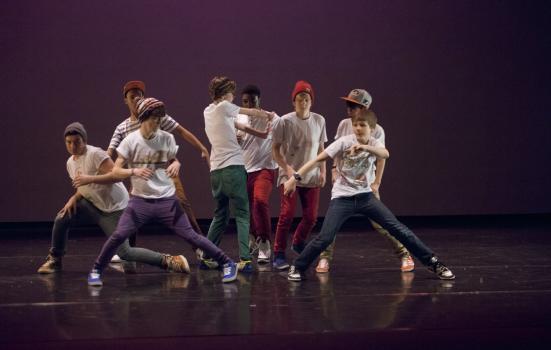The Scottish Government’s youth arts strategy aims to increase engagement in the arts as well as tackle inequality. Fiona Hyslop outlines how it has evolved.

I strongly believe that music, dance, art, literature and theatre help us all to broaden our horizons, challenge our preconceptions, promote awareness of other cultures and experiences, and move us towards a deeper understanding of the world we live in. My One Scotland programme underlined how we will create a wealthier and more equal society, and tackling social justice and reducing inequalities is one of our most important priorities. We know that through the well-established links between cultural engagement, attainment, skills and personal development, the arts have a key role to play in tackling these issues.
There are well-established links between cultural engagement, good health and life satisfaction. What’s more, we know the importance of starting young, with those who are encouraged to take part in cultural activities while young being more likely to engage in culture as adults. As we saw in Scotland during the debate on independence, young people are passionate when they are given the opportunity to make their voices heard and have an active role in shaping society. If we want to end inequality then young people need to be part of the process and we need to harness their thirst for change and creativity. Scotland already has a vibrant youth arts sector, but some young people experience barriers to full participation often involving cost, transport, geography, or a lack of access to activities that interest them.
A country that treats the arts as the province of a few gifted children, or views them only as recreation and entertainment, is a nation that has given up both on itself and its future
Time to Shine is our first National Youth Arts strategy and was launched in November 2013. Its vision to “support all of Scotland’s children and young people to flourish and achieve in and through the arts and creativity” is delivered by our national arts body, Creative Scotland. Young people are at the heart of the strategy’s aims and ambitions - young people’s views were fundamental to the shaping of the strategy and a national young people’s advisory group has been set up to ensure that they play a key role in shaping its delivery. In addition, one of the key principles underpinning the strategy is the need to tackle inequalities. For example, the strategy recognises and aims to address that black, Asian & minority ethnic (BAME) groups are underrepresented in the arts. It also acknowledges that disabled people and young people from deprived backgrounds face their own unique barriers. At all levels of delivery we need to work together to take forward an inclusive approach to involving young people in the development of arts services. Listening to a range of voices including young people with disabilities, those from a variety of ethnic and cultural backgrounds and from across the age range is vital to getting the services right.
To help take this approach forward with young people, last April we announced £3.1m of funding for a network of regional Youth Arts Hubs to improve youth arts provision across the country. These hubs in Aberdeen and Aberdeenshire, Moray, Highlands, West Dunbartonshire, Glasgow, Argyle & Bute, Ayrshire, Edinburgh and Fife have been developed through partnerships between local and national arts and youth services providers. They act as focal points for regional youth arts delivery and will nurture and celebrate ambition, enthusiasm and talent in our young people. Notable developments so far include the launch of a new youth arts digital platform for Fife, the introduction of a youth-led arts network for Ayrshire, a pioneering programme of new arts delivery for West Dunbartonshire and the creation of an arts traineeships and apprenticeships scheme for young people in Edinburgh.
In addition to these hubs, targeted project funding is supporting An Lanntair in the Western Isles, and Voice of my Own in the Scottish Borders, to give young people in remote and rural areas better access to the arts.
Government funding also helps to support programmes such as Get Scotland Dancing and the Youth Music Initiative. Get Scotland Dancing brought dance to 66,000 participants throughout Scotland as part of the legacy for the Commonwealth Games. The Youth Music Initiative opens up access to high-quality music-making opportunities for young people, particularly for those that would not normally have the chance to participate. It has created career pathways for Scotland’s young talent as well as giving many thousands of young people across the country the opportunity to learn about and enjoy making music. Despite budget pressure we have protected projects that are helping young people across Scotland get involved in the arts.
Time to Shine is also supported by initiatives including Cashback for Creativity, which uses the proceeds of crime in a positive way to expand young people’s horizons. The scheme increases their opportunities to develop their interest and skills, helping many participants advance on to education, training and employment, making a huge difference to their quality of life.
In November last year we announced an additional £1m of public and private funding for the national youth arts companies to deepen youth arts participation in the run-up to Scotland’s Year of Young People in 2018. It will be an important year when an exciting programme of educational and cultural events will be centred on one of Scotland’s great assets, our young people.
It is our duty as a government to encourage our young people to learn a love, a curiosity and a value for culture, regardless of their class, background or where they live. A country that treats the arts as the province of a few gifted children, or views them only as recreation and entertainment, is a nation that has given up both on itself and its future.
Fiona Hyslop is the Cabinet Secretary for Culture, Europe and External Affairs in the Scottish Government.
www.gov.scot




